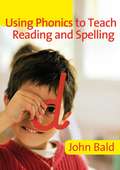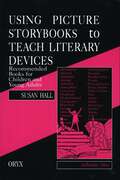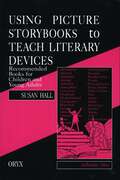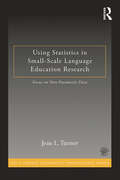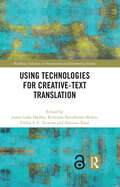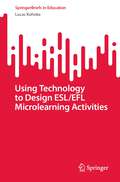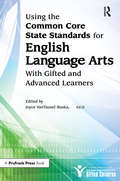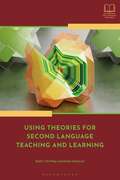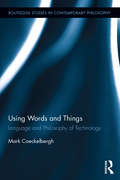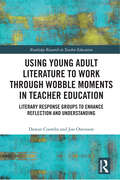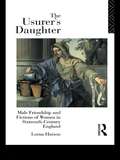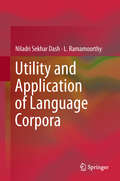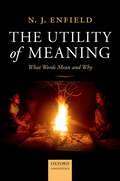- Table View
- List View
Using Phonics to Teach Reading & Spelling (PDF)
by John BaldIncludes CD-Rom Times Educational Supplement Star Read! 'This is an authoritative yet lively and eminently readable book. It is well grounded in both the latest academic theory and experienced hands-on pedagogic practice, and it summarises succinctly the implications of the recent Rose Report, giving a masterly exposition of both synthetic and analytic phonics and their places in the processes of learning to read and spell. Practical and organisational issues are tackled in a most supportive way, with very useful checklists and photocopiable proformas on an accompanying CD. The book also provides and excellent guide to provision for professional development, involving the use of lesson observation and part of the evaluation and planning cycle for CPD. Its style is clear and well signposted with subheadings, case-study boxes to illuminate points, and with aims given at the start of each chapter as well as challenging points for reflection and guides to further reading at the ends. Every staff room should have one!' - Dorothy Latham, Primary Education Consultant, English specialist and author of How Children Learn to Write 'Synthetic phonics may well be only one tool for teaching reading and spelling, but it is the single most important one' - Ruth Kelly, Education Secretary, March 2006 'Teachers - and particularly Literacy Co-ordinators or SENCOs - who are enthusiastic about children's learning and about their own professional development will undoubtedly benefit from using this book and CD, with its combination of useful explanation and practical resources to support the implementation of the ideas' - Lorna Gardiner, General Adviser, Foundation Stage, North Eastern Education and Library Board, Northern Ireland Are you looking for practical advice on how to teach phonics? By giving the reader a basic introduction to teaching reading and spelling using phonics, this book will provide you with easy-to-use ideas for your classrooms. Following on from the recommendations of the Rose Report, the author explains why teaching phonics works, and how to present irregular as well as straightforward features of English. The book: o contains practical examples and activities for teachers o explains the basis of synthetic and analytic phonics o gives advice on choosing the best resources o looks at how to help the weakest readers o includes a CD Rom with photocopiable resources and INSET materials o contains a glossary of key terms Literacy Co-ordinators, teachers and teaching assistants will find this an invaluable resource.
Using Picture Storybooks to Teach Literary Devices: Recommended Books for Children and Young Adults (Using Picture Books to Teach)
by Susan HallThe third volume of Using Picture Storybooks to Teach Literary Devices joins volumes 1 and 2 of this best-selling series to give teachers and librarians the perfect tool to teach literary devices to students in grades K-12. In this volume, 120 well-reviewed picture storybooks, published mainly in the last few years, are listed (sometimes more than once) under 41 literary devices. All-ages picture storybooks, which can be enjoyed by adults, as well as children, are included. For each device, a definition is given, and descriptions of appropriate storybooks, with information on how to use them, the art style used in the book, and a curriculum tie-in, are provided. Among the literary devices included are alliteration, analogy, flashback, irony, metaphor, paradox, tone, and 34 more. Indexes by author, title, art style, and curriculum tie-in add to this outstanding book's great value. Grades 4-12.
Using Picture Storybooks to Teach Literary Devices: Recommended Books for Children and Young Adults (Using Picture Books to Teach)
by Susan HallThe third volume of Using Picture Storybooks to Teach Literary Devices joins volumes 1 and 2 of this best-selling series to give teachers and librarians the perfect tool to teach literary devices to students in grades K-12. In this volume, 120 well-reviewed picture storybooks, published mainly in the last few years, are listed (sometimes more than once) under 41 literary devices. All-ages picture storybooks, which can be enjoyed by adults, as well as children, are included. For each device, a definition is given, and descriptions of appropriate storybooks, with information on how to use them, the art style used in the book, and a curriculum tie-in, are provided. Among the literary devices included are alliteration, analogy, flashback, irony, metaphor, paradox, tone, and 34 more. Indexes by author, title, art style, and curriculum tie-in add to this outstanding book's great value. Grades 4-12.
Using Priming Methods in Second Language Research (Second Language Acquisition Research Series)
by Kim McDonough Pavel TrofimovichUsing Priming Methods in Second Language Research is an accessible introduction to the use of auditory, semantic, and syntactic priming methods for second language (L2) processing and acquisition research. It provides a guide for the use, design, and implementation of priming tasks and an overview of how to analyze and report priming research. Key principles about auditory, semantic, and syntactic priming are introduced, and issues for L2 researchers to consider when designing priming studies are pointed out. Empirical studies that have adopted priming methods are highlighted to illustrate the application of experimental techniques from psychology to L2 processing and acquisition research. Each chapter concludes with follow-up questions and activities that provide additional reinforcement of the chapter content, while the final chapter includes data sets that can be used to practice the statistical tests commonly used with priming data.
Using Priming Methods in Second Language Research (Second Language Acquisition Research Series)
by Kim McDonough Pavel TrofimovichUsing Priming Methods in Second Language Research is an accessible introduction to the use of auditory, semantic, and syntactic priming methods for second language (L2) processing and acquisition research. It provides a guide for the use, design, and implementation of priming tasks and an overview of how to analyze and report priming research. Key principles about auditory, semantic, and syntactic priming are introduced, and issues for L2 researchers to consider when designing priming studies are pointed out. Empirical studies that have adopted priming methods are highlighted to illustrate the application of experimental techniques from psychology to L2 processing and acquisition research. Each chapter concludes with follow-up questions and activities that provide additional reinforcement of the chapter content, while the final chapter includes data sets that can be used to practice the statistical tests commonly used with priming data.
Using The River (Rigby Star Guided #Lime Level)
by Claire LlewellynRigby Star is a guided reading programme developed specifically to meet the requirements of the NLS. It offers stories and teaching support to help plan and manage guided reading lessons - all within a structured reading programme. Teaching versions offer support for every title, with prompts for discussing the story summary; preparing pupils for the walkthrough, in which the pupils think about such clues to the book as the blurb, the cover image and title. The readers are part of a carefully levelled structure to help ensure that every child has the right book, at the right time. Every book has links to independent/group reading and writing activities. The scheme also offers support for follow-up and assessment, such as suggestions for further activities and assessment. There is a writing activity linked to every book.
Using The River (Rigby Star Guided #Lime Level)
by Claire LlewellynRigby Star is a guided reading programme developed specifically to meet the requirements of the NLS. It offers stories and teaching support to help plan and manage guided reading lessons - all within a structured reading programme. Teaching versions offer support for every title, with prompts for discussing the story summary; preparing pupils for the walkthrough, in which the pupils think about such clues to the book as the blurb, the cover image and title. The readers are part of a carefully levelled structure to help ensure that every child has the right book, at the right time. Every book has links to independent/group reading and writing activities. The scheme also offers support for follow-up and assessment, such as suggestions for further activities and assessment. There is a writing activity linked to every book.
Using Statistics in Small-Scale Language Education Research: Focus On Non-parametric Data (Esl And Applied Linguistics Professional Ser.)
by Jean TurnerAssuming no familiarity with statistical methods, this text for language education research methods and statistics courses provides detailed guidance and instruction on principles of designing, conducting, interpreting, reading, and evaluating statistical research done in classroom settings or with a small number of participants. While three different types of statistics are addressed (descriptive, parametric, non-parametric) the emphasis is on non-parametric statistics because they are appropriate when the number of participants is small and the conditions for use of parametric statistics are not satisfied. The emphasis on non-parametric statistics is unique and complements the growing interest among second and foreign language educators in doing statistical research in classrooms. Designed to help students and other language education researchers to identify and use analyses that are appropriate for their studies, taking into account the number of participants and the shape of the data distribution, the text includes sample studies to illustrate the important points in each chapter and exercises to promote understanding of the concepts and the development of practical research skills. Mathematical operations are explained in detail, and step-by-step illustrations in the use of R (a very powerful, online, freeware program) to perform all calculations are provided. A Companion Website extends and enhances the text with PowerPoint presentations illustrating how to carry out calculations and use R; practice exercises with answer keys; data sets in Excel MS-DOS format; and quiz, midterm, and final problems with answer keys.
Using Statistics In Small-scale Language Education Research: Focus On Non-parametric Data (Esl And Applied Linguistics Professional Ser.)
by Jean TurnerAssuming no familiarity with statistical methods, this text for language education research methods and statistics courses provides detailed guidance and instruction on principles of designing, conducting, interpreting, reading, and evaluating statistical research done in classroom settings or with a small number of participants. While three different types of statistics are addressed (descriptive, parametric, non-parametric) the emphasis is on non-parametric statistics because they are appropriate when the number of participants is small and the conditions for use of parametric statistics are not satisfied. The emphasis on non-parametric statistics is unique and complements the growing interest among second and foreign language educators in doing statistical research in classrooms. Designed to help students and other language education researchers to identify and use analyses that are appropriate for their studies, taking into account the number of participants and the shape of the data distribution, the text includes sample studies to illustrate the important points in each chapter and exercises to promote understanding of the concepts and the development of practical research skills. Mathematical operations are explained in detail, and step-by-step illustrations in the use of R (a very powerful, online, freeware program) to perform all calculations are provided. A Companion Website extends and enhances the text with PowerPoint presentations illustrating how to carry out calculations and use R; practice exercises with answer keys; data sets in Excel MS-DOS format; and quiz, midterm, and final problems with answer keys.
Using Technologies for Creative-Text Translation (Routledge Advances in Translation and Interpreting Studies)
by James Luke Hadley Kristiina Taivalkoski-Shilov Carlos S. C. Teixeira Antonio ToralThis collection reflects on the state of the art of research into the use of translation technologies in the translation of creative texts, encompassing literary texts but also extending beyond to cultural texts, and charts their development and paths for further research. Bringing together perspectives from scholars across the discipline, the book considers recent trends and developments in technology that have spurred growing interest in the use of computer-aided translation (CAT) and machine translation (MT) tools in literary translation. Chapters examine the relationships between translators and these tools–the extent to which they already use such technologies, the challenges they face, and prevailing attitudes towards these tools–as well as the ethical implications of such technologies in translation practice. The volume gives special focus to drawing on examples with and beyond traditional literary genres to look to these technologies’ use in working with the larger group of creative texts, setting the stage for many future research opportunities. The book will be of particular interest to students and scholars in translation studies, especially those with an interest in literary translation, translation technology, translation practice, and translation ethics.
Using Technologies for Creative-Text Translation (Routledge Advances in Translation and Interpreting Studies)
by James Luke Hadley Kristiina Taivalkoski-Shilov Antonio Toral Teixeira, Carlos S. C.This collection reflects on the state of the art of research into the use of translation technologies in the translation of creative texts, encompassing literary texts but also extending beyond to cultural texts, and charts their development and paths for further research. Bringing together perspectives from scholars across the discipline, the book considers recent trends and developments in technology that have spurred growing interest in the use of computer-aided translation (CAT) and machine translation (MT) tools in literary translation. Chapters examine the relationships between translators and these tools–the extent to which they already use such technologies, the challenges they face, and prevailing attitudes towards these tools–as well as the ethical implications of such technologies in translation practice. The volume gives special focus to drawing on examples with and beyond traditional literary genres to look to these technologies’ use in working with the larger group of creative texts, setting the stage for many future research opportunities. The book will be of particular interest to students and scholars in translation studies, especially those with an interest in literary translation, translation technology, translation practice, and translation ethics.
Using Technology to Design ESL/EFL Microlearning Activities (SpringerBriefs in Education)
by Lucas KohnkeThis book provides strategies, tools, and best practices for incorporating microlearning in English language teaching. It aims to help teachers create and deliver microlearning mechanisms that are optimized for mobile learning. This book also draws on relevant literature and the author’s first-hand experience designing microlearning activities for English learners. It covers important aspects of microlearning, including artificial intelligence, virtual reality, augmented reality, and mixed modalities. It is an important starting point for teachers, academics, and researchers interested in the principles and practice of microlearning in English language teaching. English language teachers in formal and informal education environments find this work thought-provoking, instructive, and informative and benefit from exploring the possibilities of microlearning to motivate and engage learners and maximize the number and quality of their learning experiences.
Using the Common Core State Standards for English Language Arts With Gifted and Advanced Learners
by National Assoc For Gifted ChildrenUsing the Common Core State Standards for English Language Arts With Gifted and Advanced Learners provides teachers and administrators examples and strategies to implement the new Common Core State Standards (CCSS) with advanced learners at all stages of development in K-12 schools. The book describes—and demonstrates with specific examples from the CCSS—what effective differentiated activities in English language arts look like for top learners. It shares how educators can provide both rigor and relevance within the new standards as they translate them into meaningful experiences for gifted and advanced learners.
Using the Common Core State Standards for English Language Arts With Gifted and Advanced Learners
by National Assoc For Gifted ChildrenUsing the Common Core State Standards for English Language Arts With Gifted and Advanced Learners provides teachers and administrators examples and strategies to implement the new Common Core State Standards (CCSS) with advanced learners at all stages of development in K-12 schools. The book describes—and demonstrates with specific examples from the CCSS—what effective differentiated activities in English language arts look like for top learners. It shares how educators can provide both rigor and relevance within the new standards as they translate them into meaningful experiences for gifted and advanced learners.
Using the Encyclopédie: Ways of Knowing, Ways of Reading (Oxford University Studies in the Enlightenment #2002:05)
As editors of the Encyclopédie, Diderot and D'Alembert claimed that one of the work's greatest strengths was that the knowledge it contained was useful. It was indeed, for the Encyclopédie assembled existing knowledge from a wide range of fields, making that knowledge potentially accessible to a broad readership. In addition, the Encyclopédie contributed to creating new areas of inquiry and forming new knowledge in vast fields now called science and technology, the arts and humanities. The sheer amount of knowledge contained in the pages of the Encyclopédie is impressive enough. But what the encyclopedists aimed for was a way to put knowledge to work. What they sought above all was a way to fashion critical knowledge, the kind designed to demystify readers, to ‘undeceive them’ as Diderot put it, and thus to free them from the reign of superstition, doctrine, and received ideas. The Encyclopédiedoes aim to advance the Enlightenment project in this fashion. It also contains voices that are hostile or merely indifferent to such a grandiose project. Yet ultimately, the encyclopedists are correct in their claim that the Encyclopédie provides a stronger, more powerful way of knowing things, one more able to resist or at least to situate critically prior ways of knowing. A century and a half after the appearance of the first volume of the Encyclopédie in 1751, as we open its pages – or view them on-line or from a CD-Rom – what the encyclopedists knew is of less importance to us now than how they knew.Or rather, to understand what the Encyclopédie presents to its readers in the way of knowledge, we must also consider how that knowledge is to be read. For us today, the most fascinating, compelling, and challenging aspect of this daring, monumental experiment is the way it entwines what the present volume calls ways of knowing and ways of reading. Thanks to the extensive scholarship of literary and cultural historians, we now know more than ever about the Encyclopédie project, from the socio-intellectual networks to which individual encyclopedists belonged, to the print culture networks through which their work circulated. Building on that contextual knowledge, the present volume returns to the text of the Encyclopédie in a series of essays that consider, in various ways, the encyclopedic relation to knowledge. The range of topics treated here is broad, corresponding quite naturally to the breadth of the Encyclopédie itself. But these essays call us to reflect on the twin issues of epistemology and history, exploring the questions, debates, and paradigms in terms of which critical knowledge is produced in the eighteenth century, as well as in our own.
Using Theories for Second Language Teaching and Learning (Bloomsbury Guidebooks for Language Teachers)
by Dale T. Griffee Professor Greta GorsuchThis book helps second language teachers use theories in their practice, exploring in concrete and practical ways the intersections between teachers, learners, and institutions, and theories of teaching, theories of learning, and theories of language. These intersections provide language teachers with critical insights on how to deal with professional complexities and practical guidance on how to develop appropriate pedagogical practice. By focusing on theories of teaching, the authors give readers the tools to create a clear image of the kind of teacher they wish to be. By exploring theories of learning, they promote the formation of teachers' personal theories which allow them to identify their own areas of special interest in learner achievement and enrichment. By examining theories of language, the book shows how administrators and teachers can use theories to identify course goals and plan priorities for class time. Using Theories for Second Language Teaching and Learning treats theory as a concept in its own right and promotes knowing theory as a means of teacher discovery, reflection, and learning through case studies, which are descriptions and analyses of teachers thinking and acting in classrooms and in the institutions in which they work. Every chapter presents case studies with examples from the teaching of different languages, including Chinese, English, French, German, and Korean. An array of theories from multiple disciplines are featured and reflective projects are offered that lead readers to discover the importance and role of theory in daily professional life.
Using Theories for Second Language Teaching and Learning (Bloomsbury Guidebooks for Language Teachers)
by Dale T. Griffee Professor Greta GorsuchThis book helps second language teachers use theories in their practice, exploring in concrete and practical ways the intersections between teachers, learners, and institutions, and theories of teaching, theories of learning, and theories of language. These intersections provide language teachers with critical insights on how to deal with professional complexities and practical guidance on how to develop appropriate pedagogical practice. By focusing on theories of teaching, the authors give readers the tools to create a clear image of the kind of teacher they wish to be. By exploring theories of learning, they promote the formation of teachers' personal theories which allow them to identify their own areas of special interest in learner achievement and enrichment. By examining theories of language, the book shows how administrators and teachers can use theories to identify course goals and plan priorities for class time. Using Theories for Second Language Teaching and Learning treats theory as a concept in its own right and promotes knowing theory as a means of teacher discovery, reflection, and learning through case studies, which are descriptions and analyses of teachers thinking and acting in classrooms and in the institutions in which they work. Every chapter presents case studies with examples from the teaching of different languages, including Chinese, English, French, German, and Korean. An array of theories from multiple disciplines are featured and reflective projects are offered that lead readers to discover the importance and role of theory in daily professional life.
Using Words and Things: Language and Philosophy of Technology (Routledge Studies in Contemporary Philosophy)
by Mark CoeckelberghThis book offers a systematic framework for thinking about the relationship between language and technology and an argument for interweaving thinking about technology with thinking about language. The main claim of philosophy of technology—that technologies are not mere tools and artefacts not mere things, but crucially and significantly shape what we perceive, do, and are—is re-thought in a way that accounts for the role of language in human technological experiences and practices. Engaging with work by Wittgenstein, Heidegger, McLuhan, Searle, Ihde, Latour, Ricoeur, and many others, the author critically responds to, and constructs a synthesis of, three "extreme", idealtype, untenable positions: (1) only humans speak and neither language nor technologies speak, (2) only language speaks and neither humans nor technologies speak, and (3) only technology speaks and neither humans nor language speak. The construction of this synthesis goes hand in hand with a narrative about subjects and objects that become entangled and constitute one another. Using Words and Things thus draws in central discussions from other subdisciplines in philosophy, such as philosophy of language, epistemology, and metaphysics, to offer an original theory of the relationship between language and (philosophy of) technology centered on use, performance, and narrative, and taking a transcendental turn.
Using Words and Things: Language and Philosophy of Technology (Routledge Studies in Contemporary Philosophy)
by Mark CoeckelberghThis book offers a systematic framework for thinking about the relationship between language and technology and an argument for interweaving thinking about technology with thinking about language. The main claim of philosophy of technology—that technologies are not mere tools and artefacts not mere things, but crucially and significantly shape what we perceive, do, and are—is re-thought in a way that accounts for the role of language in human technological experiences and practices. Engaging with work by Wittgenstein, Heidegger, McLuhan, Searle, Ihde, Latour, Ricoeur, and many others, the author critically responds to, and constructs a synthesis of, three "extreme", idealtype, untenable positions: (1) only humans speak and neither language nor technologies speak, (2) only language speaks and neither humans nor technologies speak, and (3) only technology speaks and neither humans nor language speak. The construction of this synthesis goes hand in hand with a narrative about subjects and objects that become entangled and constitute one another. Using Words and Things thus draws in central discussions from other subdisciplines in philosophy, such as philosophy of language, epistemology, and metaphysics, to offer an original theory of the relationship between language and (philosophy of) technology centered on use, performance, and narrative, and taking a transcendental turn.
Using Young Adult Literature to Work through Wobble Moments in Teacher Education: Literary Response Groups to Enhance Reflection and Understanding (Routledge Research in Teacher Education)
by Dawan Coombs Jon OstensonThis volume offers a novel approach to exploring how literary response groups can be used as part of teacher education programs to help preservice teachers navigate "wobble" moments. Focusing uniquely on the potential of young adult literature (YAL), the text draws on the first-hand experiences of teacher candidates and uses a range of well-known books to demonstrate how narrative-based inquiry and analysis of fictional depictions of teaching and learning can support reflection on a range of common challenges. The volume presents how YAL literary response groups are shown to enhance participants’ ability to reflect on practice, build resilience, and develop deeper understanding of pedagogical principles by offering a shared dialogical space. These insights ultimately contribute to teacher education program improvement by enhancing teacher candidates’ understanding of pedagogy. This text will benefit researchers, doctoral students, and academics in the fields of teaching, teacher mentoring, and teacher education more specifically. Those interested in literature studies and young adult literature (YAL) more broadly will also benefit from this volume.
Using Young Adult Literature to Work through Wobble Moments in Teacher Education: Literary Response Groups to Enhance Reflection and Understanding (Routledge Research in Teacher Education)
by Dawan Coombs Jon OstensonThis volume offers a novel approach to exploring how literary response groups can be used as part of teacher education programs to help preservice teachers navigate "wobble" moments. Focusing uniquely on the potential of young adult literature (YAL), the text draws on the first-hand experiences of teacher candidates and uses a range of well-known books to demonstrate how narrative-based inquiry and analysis of fictional depictions of teaching and learning can support reflection on a range of common challenges. The volume presents how YAL literary response groups are shown to enhance participants’ ability to reflect on practice, build resilience, and develop deeper understanding of pedagogical principles by offering a shared dialogical space. These insights ultimately contribute to teacher education program improvement by enhancing teacher candidates’ understanding of pedagogy. This text will benefit researchers, doctoral students, and academics in the fields of teaching, teacher mentoring, and teacher education more specifically. Those interested in literature studies and young adult literature (YAL) more broadly will also benefit from this volume.
The Usurer's Daughter: Male Friendship and Fictions of Women in 16th Century England
by Lorna HutsonIn a bold and brilliantly persuasive series of moves, Lorna Hutson draws upon new historicist and feminist theories to examine closely Renaissance literature and the cultural impact of the humanist project. The Usurer's Daughter: * provides startling new readings of Shakespeare * takes an entirely new approach to classical scholarship * focuses attention on the central importance of the history of the representation of women * illuminates how social relations between men were textualised during the early modern period.
The Usurer's Daughter: Male Friendship and Fictions of Women in 16th Century England
by Lorna HutsonIn a bold and brilliantly persuasive series of moves, Lorna Hutson draws upon new historicist and feminist theories to examine closely Renaissance literature and the cultural impact of the humanist project. The Usurer's Daughter: * provides startling new readings of Shakespeare * takes an entirely new approach to classical scholarship * focuses attention on the central importance of the history of the representation of women * illuminates how social relations between men were textualised during the early modern period.
Utility and Application of Language Corpora
by Niladri Sekhar Dash L. RamamoorthyThis book discusses some of the basic issues relating to corpus generation and the methods normally used to generate a corpus. Since corpus-related research goes beyond corpus generation, the book also addresses other major topics connected with the use and application of language corpora, namely, corpus readiness in the context of corpus sanitation and pre-editing of corpus texts; the application of statistical methods; and various text processing techniques. Importantly, it explores how corpora can be used as a primary or secondary resource in English language teaching, in creating dictionaries, in word sense disambiguation, in various language technologies, and in other branches of linguistics. Lastly, the book sheds light on the status quo of corpus generation in Indian languages and identifies current and future needs.Discussing various technical issues in the field in a lucid manner, providing extensive new diagrams and charts for easy comprehension, and using simplified English, the book is an ideal resource for non-native English readers. Written by academics with many years of experience teaching and researching corpus linguistics, its focus on Indian languages and on English corpora makes it applicable to graduate and postgraduate students of applied linguistics, computational linguistics and language processing in South Asia and across countries where English is spoken as a first or second language.
The Utility of Meaning: What Words Mean and Why
by N. J. EnfieldThis book argues that the complex, anthropocentric, and often culture-specific meanings of words have been shaped directly by their history of 'utility' for communication in social life. N. J. Enfield draws on semantic and pragmatic case studies from his extensive fieldwork in Laos to investigate a range of semantic fields including emotion terms, culinary terms, landscape terminology, and honorific pronouns, among many others. These studies form the building blocks of a conceptual framework for understanding meaning in language. The book argues that the goals and relevancies of human communication are what bridge the gap between the private representation of language in the mind and its public processes of usage, acquisition, and conventionalization in society. Professor Enfield argues that in order to understand this process, we first need to understand the ways in which linguistic meaning is layered, multiple, anthropocentric, cultural, distributed, and above all, useful. This wide-ranging account brings together several key strands of research across disciplines including semantics, pragmatics, cognitive linguistics, and sociology of language, and provides a rich account of what linguistic meaning is like and why.
